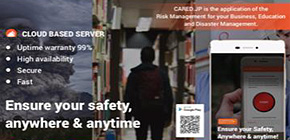
Multilingual safety confirmation app put to practical use
Users can record scenes of the disaster and ambient sounds by pressing a panic button and send them to preset receivers
Professor Toshiya Tsukamoto of the Osaka School of International Public Policy at Osaka University developed Cared.jp, a mobile app for the Multilingual Disaster Information System, by which users can send messages from their cell phone.
Based on information from people affected by disasters gathered by their answers to simple questions on the smartphone app, disaster damage is visually displayed on a map. On this map, each dot represents the level of damage, with a red dot representing 70% to 100% damage, a yellow dot representing 30% to 70% damage, and a green dot representing 0% to 30% damage.
This app was launched on April 20, 2018. It is currently available in 6 languages (Japanese, English, Chinese, Korean, Vietnamese, and Indonesian), but it will be available in 10 or more languages by the end of March 2019.
Users need to download this app and sign up for the Cloud platform for an annual registration fee of 500 yen to send messages, including those regarding their safety, location, and contact address, to preset receivers simultaneously in their own language via email, SMS, Facebook, and LINE.
In addition to safety confirmation during normal times, in times of natural disasters or terrorist-related incidents, users can record scenes of the disaster and ambient sounds for 10 seconds by pressing a panic button twice and automatically send them to preset receivers.
This app allows users to send emails to multiple recipients at the same time, so it’s possible for educational institutes such as universities to manage safety confirmation by department, major, laboratory, class, or group with this app alone during overseas training or in times of disaster in Japan. Administrative organizations can use the information to get a picture of the disaster and plan for emergency relief work as well.
Moving forward, the researchers will advance their development in cooperation with companies so that this app can be used more quickly in 15 languages and through popular overseas messaging apps, such as WeChat and KakaoTalk. By working with companies that offer users free Internet access via Wi-Fi in times of disaster, the researchers will be able to create a system in which one can receive multilingual news relating to disasters via a Wi-Fi Internet connection.
Related link
